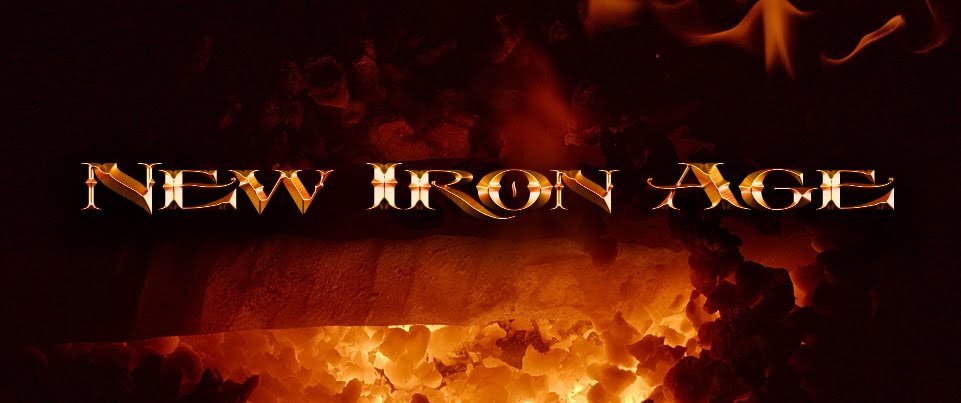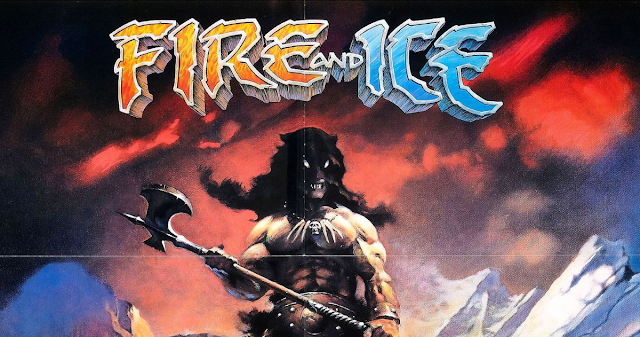Ralph
Bakshi has acquired a reputation as a great producer of underground
animation, despite that he was never very good at it, which says
something about the state of non-kid-oriented animation in the US, I
suppose. Wizards remains an almost unwatchable piece of crap,
and yet it was successful enough for Bakshi to get his half-assed
Lord of the Rings film semi-produced. Despite that film
making enough money to justify a sequel, investors weren’t
interested, and the thing remains essentially unfinished. But by the
early 80s, fantasy films had become more mainstream, and so Bakshi
was finally able to get a project going with longtime friend Frank
Frazetta, which in 1983 became perpetual cult film Fire and Ice.
I
remember people being rather excited for this, as the combination of
the underground prince of adult animation with the man who was, at
the time, unquestionably the greatest living fantasy artist sounded
like a ticket to awesomness. Frazetta was still at the height of his
powers, and an animated version of his bloody, sensual, barbaric
world seemed like it could be nothing but amazing. The script was to
be written by Gerry Conway and Roy Thomas – both veterans of Conan
in the comics. Roy Thomas, in particular, was responsible for
creating the long-running Savage Sword of Conan, which
showcased some of the best Sword & Sorcery writing and comics art
in the world.
Unfortunately,
despite the strong pedigree, Fire and Ice ends up being a
magnification of the creator’s various flaws, rather than a
combination of their strengths. Bakshi at his best can be visually
arresting and innovative, but without someone to push him he is lazy,
and the animation here is full of sketchy animation, reused shots,
and other such shortcuts. There are literally a few moments when you
can see elements were done in pencil and just never finished or
inked. The rotoscoping creates very fluid, lifelike animations, but
there is too much reliance on that, and not enough detail to add
richness or depth, leaving the characters looking flat.
Frazetta
at his best is iconic and evocative, but he was often too rough and
impressionistic for what the work needed, and to animate his style
you would need someone to sharpen him up, as Ron Cobb did for the
movies. Bakshi is not that guy, and the combination of Frazetta’s
loose designs with Bakshi’s unfinished approach makes for a movie
that is colorful but has an incomplete, unpolished look. In a lot of
scenes, the best parts are Thomas Kinkade or James Gurney’s
backgrounds.
The
script, by Conway and Thomas, is similarly rough and
unfinished-seeming. The dialogue is bland, and the plot is
simplistic and rote. Evil Lord Nekron rides a glacier palace to
destroy the southern lands and wipe out the peaceful, stone-aged
inhabitants, seemingly just for the hell of it. He is urged on by
his villainous mother, who seems to serve no purpose in the story at
all. His minions are a horde of unpleasant racist stereotypes termed
the “subhumans”, who are all dark-skinned and hoot and grunt,
while all the heroes are white.
Our
ostensible protagonist, Larn, survives an attack by Nekron and then
heads off in a seemingly random direction on a quest for vengeance –
despite that it would seemingly be hard to lose track of a giant
glacier. Along the way he encounters Teegra, Standard Kidnapped
Princess, and tries to save her from the subhumans while the camera
lingers on her bikini-clad body to a degree that is almost
embarrassing. There are a lot of elements here that don’t go
anywhere, from an encounter with a red-haired witch who gets
unceremoniously killed off, and several attacks by giant prehistoric
monsters which are fun, but only serve to slow down the already slow
plot.
Larn
is also aided by the mysterious Dark Wolf, who is so mysterious the
movie doesn’t even tell us his name, and we have to learn it from
the credits. He’s like a cross between the Death Dealer and
Batman, and he is so cool you can’t help but wonder why he’s not
the hero. He just shows up, helps Larn out, kills a lot of dudes and
then finishes off Nekron, all without his presence ever being
explained or his motivations brought up. He’s cool, but he’s
just there, and the movie really needed to pick a lead, rather than
have this guy just kind of appear without explanation.
Even
at a slight 81 minutes, Fire and Ice seems like it is stalling
for time. The cuts are long, the dialogue stilted and slow-paced.
Even the fight scenes – which are where this movie occasionally
shines – are slow and seem to take much longer than they should.
It seems like they were trying to make this iconic and epic, but they
just ended up making it bland and sluggish. As with so much of his
career, Bakshi made a movie that is notable for pushing the envelope
and trying new things, but the end result just isn’t very good,
much as I might wish it was.




